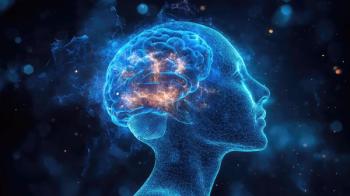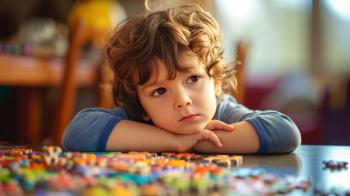
From Crisis to Coping: Strategies for Supporting Trauma-Affected Refugee Youth
Look through the eyes of a medical health care team in a refugee camp with a focus on children’s mental health.
TALES FROM THE CLINIC
-Series Editor Nidal Moukaddam, MD, PhD
In this installment of Tales of the Clinic: The Art of Psychiatry, we visit the sad worlds of refugees and migrants, and their mental health challenges. In 2022, there were almost 30 million refugees around the world, stemming from several crises from Eritrea and the Rohingya crisis to the ongoing civil war in Syria. This piece is seen through the eyes of a hypothetical medical health care team in a refugee camp, with a focus on the mental health of children.
Case Study
This is the story of “Yelena,” a 10-year-old girl in a refugee camp in one of the many regions hit by war and strife. She is taken by her mother to a temporary medical clinic for a wellness checkup, presenting with no prior medical or psychiatric history. The camp houses more than 70,000 refugees who escaped a civil war conflict. Millions of refugees were scattered across the world with injuries ranging from physical (after bombings, chemical warfare, torture, and mass murders) to psychological (
Yelena had no somatic complaints, and her physical exam was unremarkable, but she had endured a lot of
During her clinical assessment, Yelena demonstrated symptoms of agitation, reactive affect, and sporadic crying. According to her mother, she refused to sleep alone at night, experienced repeated nightmares/flashbacks, and was dependent on her mother/adults. She also was very resistant to going to school again in some of the makeshift refugee schools. She was enrolled in trauma exposure therapy,
Yelena and her family were provided transportation that allows refugees to be seen twice a week in makeshift clinics by volunteer physicians, therapists, and other health care workers. During these visits, hygiene products, medications, food, and other care packages were given to them. The children were often delighted to receive toys or candy for the first time in years. Most of the patients seen at these clinics were women and children due to the massive loss of older males who were lost in the conflict. Unfortunately, as with most of these cases, follow-up was limited.
The team encountered many cases like this where children had witnessed members of their families getting killed, sexually assaulted, or falling victim to other heinous and traumatizing events. This left medical providers perplexed as to how they could provide medical and mental health care to a population that suffered from a lack of stability and resources including food, shelter, health products, etc.
Context
More than 108.4 million individuals in the world are currently displaced. Of these, 29.4 million are
First Steps for Traumatized Children
Before delving into specific treatments for trauma, one must first establish what basic needs must be met. A useful tool is Maslow’s Hierarchy of Needs (
One example of a developed program is the Children and War Foundation’s Teaching Recovery Techniques (TRT) program. Initially developed for children in Yugoslavia in the mid-1990s following the civil war there, the program focuses on trauma-focused cognitive behavioral therapy with 7 sessions for each patient and 2 sessions for their caregivers. It focuses on stress management skills and a gradual exposure to traumatic experiences that gives children a form of control over these experiences.5 In a 2021 study that assessed TRT and other techniques in Syrian refugees in Lebanon, TRT demonstrated significant reductions in PTSD symptoms in children.6 Likewise, previous studies utilizing this technique with refugees in Sweden and Palestine mirrored these significant results.7
Literature on Coping Strategies
Limited research has been conducted on coping strategies and treatment guidelines for refugees from war-torn countries. Many common mental health issues that arise following conflict include
In Palestine, a 2003 study assessed children during the Second Intifada and found that parents reported 46% of their children had aggressive behavior, 27% reported bed wetting, and 39% reported recurrent nightmares.9 Another study in Gaza, Palestine found that 54% of children living in bombardment areas suffered from severe PTSD, while 33.5% suffered from moderate PTSD.10 This demonstrates the wide array of mental health disparities following any traumatic conflict, unstable living conditions, or witnessing/experiencing violence. Given the wide range of mental health disparities that can occur, this review will focus more on PTSD symptoms and how one can approach treatment.
When assessing which coping mechanisms children from these backgrounds should utilize, one must understand that trauma and PTSD treatments will vary widely depending on the stressor(s) experienced. Additionally, many of the traumas experienced by children from these refugee camps are incredibly disturbing and rank high on traumatic scales relative to other atrocities experienced. The first step in determining which direction may lead to positive coping skills is to assess what has worked in the past. Additionally, it must be determined whether there are correlations between varying traumatic backgrounds/experiences and positive coping mechanisms. By doing this, we may have a foundation to build upon when determining which coping mechanisms to employ in these children. The unique circumstances of each child will require tailored coping skills to find what is most beneficial to them.
Coping efficacy has the greatest inverse relationship to PTSD symptom severity.11 So how do we determine which coping strategies are most useful for children and adolescents who have PTSD or other related trauma? Unfortunately, most literature at this point has focused primarily on PTSD in adults, and consequently, most of the coping strategies currently employed are based on these adult-focused literatures. Although this may still be beneficial, it does raise doubt about how applicable these coping strategies might be for children.
Negative Coping Strategies
Previous literature has determined that PTSD symptoms of blame and anger, use of distraction, and rumination have the strongest relationship with PTSD symptom severity.11 Other negatively correlated coping strategies include emotion-focused, escape-oriented, and avoidance coping. Children who tend to rely on these strategies are more likely to experience a higher number of, as well as more severe, PTSD symptoms than their peers who do not use these strategies. Additionally, negative appraisals of the trauma experienced and disturbances in the trauma memories (poor recall, elaboration, or contextualization) are both associated with negative coping strategies that may directly increase PTSD symptoms.12 These can lead to the initiation of preventative behaviors mentioned previously such as avoidance coping, rumination, distraction, etc. This can create a vicious cycle of negative coping strategies to prevent symptom severity—which actually can make symptom severity much worse.
Positive Coping Strategies
Coping strategies that had an inverse relationship to PTSD symptom severity include belief in the ability to cope, believing in one’s own capacity, and self-distraction.13 Another common strategy that has demonstrated positive effects is what many clinicians consider the gold standard for child and adolescent treatment in traumatic settings: returning to normalcy. Establishing roles and routines in the family and at school has demonstrated significant inverse relationships to postdisaster stress and emotions. These include consistent relationships and interactions as well as assistance from families, clinicians, and educators in order to give children and adolescents a sense of predictability and normalcy even in settings where normalcy may not be achieved.14 Notably, distraction has not historically been considered a positive coping strategy by many families, clinicians, or educators. This is a bit complicated since self-distraction is beneficial. The idea behind this is that children may be more effective at managing their PTSD than many give them credit for, while others trying to distract can be a sign to the children that others around them see something wrong with them and thus are trying to distract them.14
Obstacles Preventing Treatment
The positive coping strategies previously mentioned can give children a sense of normalcy and familial connections, as well as the ability to build relationships and eventually overcome their PTSD symptoms. However, employing these strategies in a population of children who are never truly in a stable environment is challenging. In 2019, 157 schools and 105 hospitals were attacked with airstrikes, shellings, explosions, and improvised explosive devices.15 During the Syrian conflict, more than 40% of Syrian schools (more than 7000) were damaged or destroyed. Well over 3 million Syrian boys and girls stopped attending school on a regular basis, and those who continued to attend were confronted with classroom sizes of 120 children or more due to school overpopulation.15 This has resulted in massive illiteracy among children: Many children are several grade levels behind in reading, math, and other subjects; 52% and 35% of children in grade 7 and grade 8, respectively, are unable to read at a 2nd-grade level; and males have significantly higher levels of illiteracy than females.16 Encouraging these children to attend school can be a challenge because they know that these educational facilities and hospitals have been targeted historically. Although makeshift schools have been created in neighboring countries for Syrian refugees such as in Jordan and Turkey, their funding is often inconsistent and insufficient, they are typically dependent on volunteers, and the government restricts a lot of progress for them in their respective areas.
These are massive obstacles standing in the way of any form of mental health treatment for refugee children. When one does not have any stability, safety, or basic needs of living, it becomes incredibly difficult to build normalcy without addressing those underlying factors first.
Concluding Thoughts
Clinicians can support different volunteer organizations and donate to those that prioritize building new schools, shelters, and community centers for refugee children. This would facilitate coping strategies by creating normalcy and establishing regular, consistent relationships throughout their community with the assistance of families, educators, and clinicians. We hope that by creating this pseudo-normalcy in the harsh environments that refugee camps typically entail, we can minimize the level of PTSD and trauma-related symptoms that these children inevitably experience after being displaced, orphaned, hurt, and/or severely traumatized.
Mr Hamza is a 4th-year medical student at Texas A&M School of Medicine applying to psychiatry residency. He has previously worked with refugee camps in Jordan to assist with psychiatric and medical care. Dr Kawamleh is a psychiatry resident at Baylor College of Medicine with experience working with multiple Syrian humanitarian organizations.
References
1. Salem RA, Clinton HR. Witness to Genocide, The Children of Rwanda: Drawings by Child Survivors of the Rwandan Genocide of 1994. Friendship Press; 2000.
2. The UN Refugee Agency. Global trends report 2022. UNHCR. June 14, 2023. Accessed September 26, 2023. https://www.unhcr.org/global-trends-report-2022
3. 110 million people displaced around the world: get the facts. International Rescue Committee. June 13, 2023. Accessed September 26, 2023.
4. Maslow AH.
5. Yule W, Dyregrov A, Raundalen M, Smith P.
6. El-Khani A, Cartwright K, Maalouf W, et al.
7. Sarkadi A, Ådahl K, Stenvall E, et al.
8. Cardozo BL, Bilukha OO, Gotway Crawford CA, et al.
9. Mousa F, Madi H. Impact of the Humanitarian Crisis in the Occupied Palestinian Territory on People and Services. United Nations Relief and Works Agency for Palestinian Refugees in the Near East; 2003.
10. Qouta S. Trauma, Violence and Mental Health: The Palestinian Experience. SRI Qouta; 2000.
11. Prinstein MJ, La Greca AM, Vernberg EM, Silverman WK.
12. Ehlers A, Clark DM.
13. Benight CC, Bandura A.
14. Children and Armed Conflict: Report of the Secretary-General. United Nations; General Assembly Security Council. June 9, 2020. Accessed September 26, 2023.
15. Grant-Brook W. The impact of explosive weapons on children in Syria. Action on Armed Violence. December 11, 2020. Accessed September 26, 2023.
16. Impact of war on Syrian children’s learning. International Rescue Committee. March 2017. Accessed September 26, 2023.
Newsletter
Receive trusted psychiatric news, expert analysis, and clinical insights — subscribe today to support your practice and your patients.














